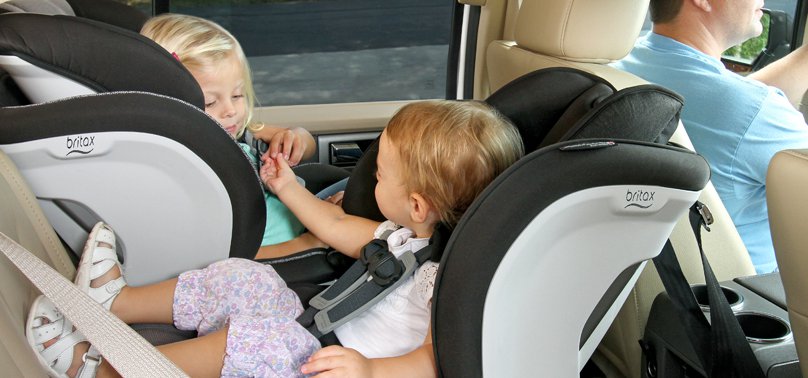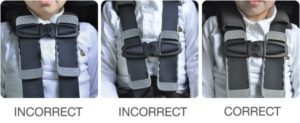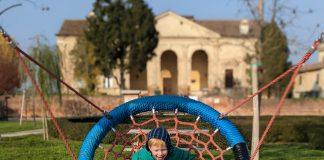 This month on the blog – in conjunction with Britax – we are thrilled to share a series of posts on child safety in honor of Month of the Military Child. Not only do Britax car seats meet all Federal Motor Vehicle Safety Standards, they go above and beyond to provide extra levels of safety. The brand also conducts more tests than required. For a military family always on the move, it’s comforting to know and trust a brand that is dedicated to keeping our kids safe — through infant car seats, convertible car seats, booster seats and strollers.
This month on the blog – in conjunction with Britax – we are thrilled to share a series of posts on child safety in honor of Month of the Military Child. Not only do Britax car seats meet all Federal Motor Vehicle Safety Standards, they go above and beyond to provide extra levels of safety. The brand also conducts more tests than required. For a military family always on the move, it’s comforting to know and trust a brand that is dedicated to keeping our kids safe — through infant car seats, convertible car seats, booster seats and strollers.
Did you know that according to the National Highway Traffic Safety Association (NHTSA), most parents are confident that they have correctly installed their child’s car seat, but in most cases (59%) the seat has not been installed correctly?!
I consider myself a bit of a car seat safety tyrant after having a pretty bad car accident a few years ago, but that statistic alone made me go back and check my car seats. What is the point of having a top of the line car seat, and a safe car when the car seat isn’t installed or used correctly?
For me, I try to follow four pretty simple rules when installing my car seats.
Don’t install your car seats when you have lots of distractions.
Don’t install your car seats when you have somewhere to be quickly.
Don’t install your car seats when when the weather isn’t cooperating.
ALWAYS read your user guide that comes with the car seat before attempting to install the seat.
I don’t know about you, but my kids are nuts, and for some reason, I always wait to switch car seats and/or change car seats between cars when both kids are with me, we are late to go somewhere, and it’s hot outside. This is a recipe for rushing and consequently not installing the car seats correctly. Plus, I get sweaty, flustered, and irrationally angry. When you know you have to mess with your car seats, plan accordingly, and make sure you’ve read and understand the user guide.
I’m not a car seat expert, though, so now I’m handing this blog post over to Charla Tabet. Among other jobs, Charla is Aviano Air Base’s Certified Child Passenger Safety Technician. She’s been a CPST for eight years.
How does one person become certified in car seat safety?
There is a 4-day intensive-learning course anyone can register for that the National Highway Traffic Safety Administration (NHTSA) developed the curriculum for. Safe Kids Worldwide administers the classes and the National Child Passenger Safety Board (NCPSB) oversees the quality and integrity of the training and certification requirements. This course includes in-class learning, written quizzes, and hands-on with many different car seat brands. It ends with a car seat check where everyone who went through the course has the opportunity to inspect the car seats of parents from around the community. The goal with the checks is to educate and equip caregivers, so they can confidently install and reinstall car seats and booster seats and to know when to move to the next stage or move to seat belts once seats are outgrown.
Do most duty stations have a person who has this skill set?
No, most don’t have a technician. Here at Aviano, we also provide checks for Vicenza (Italy). I’m not sure about stateside bases since in the states, fire stations, police stations, and some hospitals have technicians … parents would need to call their local stations or hospitals to see if they have one.
What are the most common errors you see in how people install car seats?
I should start with about 70-90 percent of car seats have some form of misuse. This means they are facing the wrong direction, the straps are too loose on the child, it’s not installed correctly in the car (too loose, not at all, or using too many seat belt options), the child has outgrown the seat, or the child isn’t in a seat at all.
What is a common misconception(s) on car seat safety?
Some of the biggest misconceptions are that you only have to check the tightness of the seat belt when it’s installed and as long as the straps are buckled, the child is safe even if the straps are too loose. Also, people turn the child forward-facing too soon because the child wants it, or his or her legs are crunched. People also take their kids out of their booster seats too soon and let them in the front seat.
Here in Italy, if the child is smaller than me, no matter the age, they should be in the back seat … I’m technically not supposed to ride in the front seat due to height and weight! It’s important for parents to follow the guidelines on the seats they are using as far as when to move on to the next seat based on weight and height, not just by age of the child.
Are there any car seat brands you tend to recommend or anything people should look for when purchasing a car seat?
I always tell parents that all seats have to meet the basic safety standards. I also highly recommend that parents see if the seat fits and works in their car (most stores will let you try it in the car before buying). If the driver can’t have his or her seat at a comfortable distance from the wheel, then the car seat needs to be moved in the car or the seat doesn’t work.
For rear-facing only infant car seats I recommend getting one that has the lower weight at 4 pounds in case the baby is small when born. As for brands I like, I recommend Britax, Graco and Chicco.
It is not recommended to buy or use a secondhand car seat unless you know the complete history of it, like if it has been in a crash, it has been recalled, and when it was bought.
Most seats are good for six or more years from the manufacture date which is on the bottom of the seat. Always refer to your user guide for specifics.
Anything else you would like us to know?
Always make sure to register your car seat with the manufacture so that if there is a recall, you can be notified. If the seat has been involved in a crash where airbags went off, someone was taken to the hospital, or the car was totalled, stop using the car seat and destroy it so that another family doesn’t risk using the seat.
In the U.S., most insurance companies will cover the replacement of the car seat in these circumstances. When using the infant seat to grocery shop, always put it in the basket and not up front unless there is a designated spot for a car seat. Too many kids end up falling from there and it can cause head injuries.
In addition to Charla’s advice, we found this Top 10 list from Britax really helpful. Charla covered most of these misuses, but the photos help illustrate exactly what she is talking about.
Misuse #1: Forward-Facing Too Soon
At Britax, we believe that children should travel rear-facing for as long as possible – ideally until they are at least two years old and their developing neck muscles have grown stronger. Rear-facing seats protect the neck and head by distributing the force of a frontal collision along the back of the seat. We believe that a less exciting view for a little person is a small compromise if it provides a safer ride. The American Academy of Pediatrics agree – visit their site to find out more.
Misuse #2: Loose Harness Straps
We know that some children don’t like being strapped in too tightly, but we do recommend that you keep the harness nice and snug. A perfect harness sits comfortably in a straigh
t line without sagging and doesn’t allow any slack. To make sure the harness is snug enough, try the simple Pinch Test.
Misuse #3: Incorrect Harness Strap Height
All children are different and grow at different rates. That’s why it’s important for you to keep an eye on how the harness height fits their body. For the best protection in case of a crash, the tops of the harness straps should be located as follows:
• Rear-Facing: At or slightly below your child’s shoulders
• Forward-Facing: At or slightly above your child’s shoulders
Misuse #4: Incorrectly Positioned Chest Clip
As the name implies, the proper position for the chest clip is on your child’s chest, at armpit level. When properly positioned, this clip helps keep the harness straps up on your child’s shoulders so they can do their job to keep your child secure during a crash.
Misuse #5: Loose Car Seat Installation
We know that a car seat can only protect your child if it has been installed securely. A securely installed car seat should not move more than 1 inch side-to-side or front-to-back at the belt path. If you have trouble installing your car seat securely, we suggest that you try the following:
• Try installing the car seat in another seating position in your vehicle. For example, if you can’t install it securely in the rear center seat, try an outboard position.
• Try installing the car seat using another installation method. For example – if you’re not able to get a secure installation using the LATCH system, try installing with the vehicle seat belt and tether.
• Consider seeking help from a certified child passenger safety technician. You can find a technician or car seat check event in your area by visiting SafeKids.org.
Misuse #6: Exceeding the LATCH Weight Limits
When it comes to installing car seats, using the LATCH (Lower Anchors and Tethers for Children) system is a popular choice. But many caregivers aren’t aware that the lower anchors have weight limits. And those limits can be different depending on which vehicle and car seat you have. So if you choose to install your child’s car seat using lower anchors, be sure to check both the car seat user guide and your vehicle owner’s manual for the weight limits, and reinstall the car seat using the vehicle seat belt when your child reaches the limit. For more on the LATCH system and lower anchor weight limits, visit About LATCH.
 Misuse #7: Not Using the Top Tether
Misuse #7: Not Using the Top Tether
At Britax, we know that every inch counts when it comes to protecting your child during a crash. That’s why we recommend that you use the top tether whenever possible. When forward-facing, the use of a top tether can reduce the distance that your child’s head moves forward during a crash by four to six inches.
Misuse #8: Installing Rear-Facing at the Wrong Angle
When children are rear-facing in a car seat, it’s important for the seat to be installed in a reclined position to help keep baby’s head and neck supported and airways clear. The recline angle is especially important for young infants who are still developing head and neck control. So when you’re installing your little one’s car seat, be sure to refer to the user guide or labels on the side of the seat and install the seat at the recline angle indicated.
Misuse #9: Using a Pre-Owned Car Seat
At Britax, we believe it’s important for every family to make smart choices that fit their unique needs and lifestyle. But when it comes to pre-owned car seats, we encourage you to use caution. For your child’s safety, as well as your own peace of mind, we recommend using a pre-owned car seat ONLY if you can answer all of the following questions: Has the car seat been in a crash? Has it been recalled? Are the user guide and all parts and pieces present? Are all the labels attached?
Misuse #10: Using an Expired Car Seat
We believe that when you put your child in a car seat, you should be able to trust that it will provide the best protection possible during a crash. We know that environmental factors like sunlight and heat can cause the materials in a car seat to degrade over time, so we recommend replacing car seats after they expire. All Britax car seats have a product life between 6 – 10 years, depending on the model. This information can usually be found on a label on the car seat or in the user guide.














